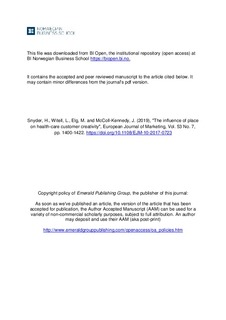The influence of place on health-care customer creativity
Journal article, Peer reviewed
Accepted version
Permanent lenke
http://hdl.handle.net/11250/2610506Utgivelsesdato
2019Metadata
Vis full innførselSamlinger
- Publikasjoner fra CRIStin - BI [981]
- Scientific articles [2153]
Sammendrag
Purpose
When using a service, customers often develop their own solutions by integrating resources to solve problems and co-create value. Drawing on innovation and creativity literature, this paper aims to investigate the influence of place (the service setting and the customer setting) on customer creativity in a health-care context.
Design/methodology/approach
In a field study using customer diaries, 200 ideas from orthopedic surgery patients were collected and evaluated by an expert panel using the consensual assessment technique (CAT).
Findings
Results suggest that place influences customer creativity. In the customer setting, customers generate novel ideas that may improve their clinical health. In the service setting, customers generate ideas that may improve the user value of the service and enhance the customer experience. Customer creativity is influenced by the role the customer adopts in a specific place. In the customer setting customers were more likely to develop ideas involving active customer roles. Interestingly, while health-care customers provided ideas in both settings, contrary to expectation, ideas scored higher on user value in the service setting than in the customer setting.
Research limitations/implications
This study shows that customer creativity differs in terms of originality, user value and clinical value depending on the place (service setting or customer setting), albeit in one country in a standardized care process.
Practical implications
The present research puts customer creativity in relation to health-care practices building on an active patient role, suggesting that patients can contribute to the further development of health-care services.
Originality/value
As the first field study to test the influence of place on customer creativity, this research makes a novel contribution to the growing body of work in customer creativity, showing that different places are more/less favorable for different dimensions of creativity. It also relates customer creativity to health-care practices and highlights that patients are an untapped source of creativity with first-hand knowledge and insights, importantly demonstrating how customers can contribute to the further development of health-care services
